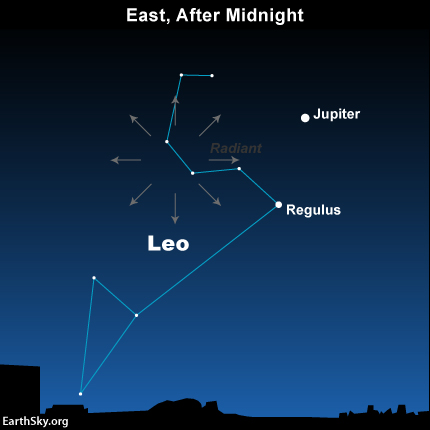Leonid meteors best between midnight and dawn November 18

Will you see what’s shown on the image at the top of this post? Thousands of meteors per hour? No. That image is from 1998, when the Leonids parent comet – Comet Temple-Tuttle – was nearby. The Leonids are famous for producing meteor storms when the comet is in our neighborhood, but no meteor storm is expected this year, only a modest 10 to 15 Leonid meteors per hour. There’s good news about this year’s shower, though. First, the waning crescent moon is more likely to enhance than hinder the 2014 meteors. Also, the brightest object in the night sky now – the planet Jupiter – is near the shower’s radiant point. So noting Jupiter’s location, and watching for meteors to spring from there, should be fun.
EarthSky lunar calendars make great gifts for astronomy-minded friends and family.
 In 2014, the very bright planet Jupiter is near the radiant point of the Leonid meteor shower. You’ll enjoy looking for Jupiter and identifying the pattern of stars from which the meteors spring.
In 2014, the very bright planet Jupiter is near the radiant point of the Leonid meteor shower. You’ll enjoy looking for Jupiter and identifying the pattern of stars from which the meteors spring.Here’s another tip regarding the radiant point. As darkness falls in mid-November, the radiant point of the shower is below your horizon, as seen from all parts of Earth. As the Earth turns, the constellation Leo the Lion – carrying the meteor shower radiant point – will rise over your eastern horizon. Expect to see the constellation Leo in the east around midnight. That’s why the Leonids begin to pick up steam after the midnight hour!
Just remember, you don’t have to locate a meteor shower radiant to watch the meteor shower.
But if the radiant isn’t in the sky, you won’t see as many meteors. That means you should watch the Leonid shower tonight, from late evening (November 17) until dawn (November 18).
As a general rule, the higher the meteor shower radiant climbs in your sky, the more meteors that you’re likely to see. The radiant for the Leonids is highest up during the dark hour before dawn, offering, perhaps, 10-15 meteors per hour. The moon may marginally interfere with the show, but not enough to worry about. You should see at least a sprinkling meteors, if you watch for an hour or so.
What else can you see on the night of the 2014 Leonids peak? The radiant for the Leonids is near the star Algieba in Leo. This is not Leo the Lion’s brightest star. That distinction goes to Leo’s star Regulus. Watch for both of these stars.
Both Algieba and Regulus belong to a noticeable pattern on the sky’s dome, in the shape of a backwards question mark. This pattern is called “the Sickle.” The paths of Leonid meteors can be traced backwards to the Sickle pattern, which is a famous asterism – or noticeable star pattern – within the constellation Leo.
By the way, the Leonids are a fast-moving meteor stream. The meteors impact the Earth at some 45 miles per second (72 km/second)! The Leonid meteor shower is known for having bright meteors or fireballs, which can punch into the atmosphere with the kinetic energy of a car hitting at 60 miles per second (nearly 100 km/hour).
Bottom line: In 2014, the Leonid meteor shower is expected to be at its best on the night of November 17-18. Usually the most meteors fall in the dark hours before dawn.













Add new comment